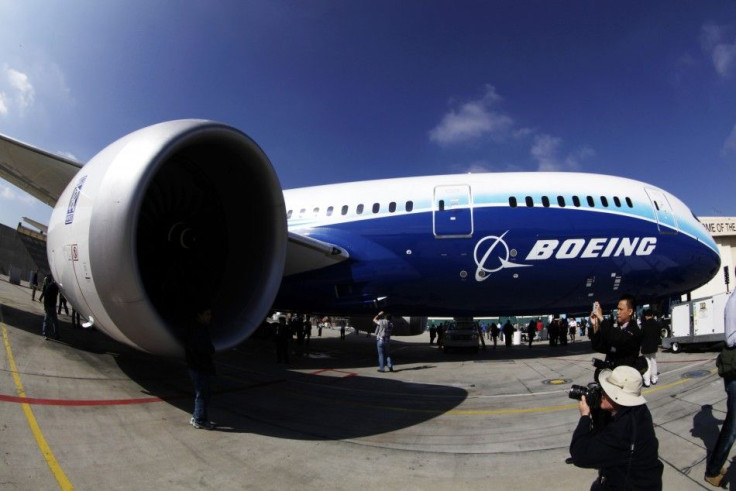FAA Approves Dreamliner Fixes, But Boeing's Timeline Unclear Regarding 787's Return To Air

Boeing received the Federal Aviation Administration's green light this week to begin crucial tests it proposed to fix its fire-prone Dreamliner planes but had few details about when its customers' flights could resume.
The 787 division's spokesperson said Boeing will return the existing fleet to service once the tests are complete and approved by the FAA, then restart deliveries. The aircraft manufacturer is extremely clear about its emphasis on safety and testing above all else, yet the only clue about time came from the 787's chief spokesperson, Scott Lefeber, who stated they intend to get the 787 back in the air "in the near term -- perhaps weeks rather than months."
Meanwhile, airlines that fly the Dreamliner are still grounded and awaiting more details from Boeing and the FAA about when their scheduled flights can resume. One of the 787's top customers, Norwegian Air Shuttle, or NAS, said it will keep its planned flights on schedule even if doing so will require shifting its planning resources over to the 787's rival liner, Airbus' A340 plane. NAS, which already has two inactive 787s in its fleet, said it has leased two A340s as backups in the event that Boeing is unable to fulfill their new orders for the Dreamliners.
"Currently, the only notification we've been given is that our April delivery is 'at risk'," Norwegian Air Shuttle spokesman Laase Sandaker-Nielsen said. The airline is planning around a delayed delivery yet still hopes to use the 787. In what it calls a backup plan, NAS confirmed that it will have the option of using Airbus' rival model. "Our flights will depart as planned," Sandaker-Nielsen said. "We will lease two A340-300 from leasing company HiFly in the event that the 787 is delayed.
Logistical Concerns
NAS, which has new routes from Oslo and Stockholm to New York and Bangkok scheduled to begin in May, is now managing logistical issues involved with the possibility of changing plane models for those routes. But switching to an entirely different plane model is not simple.
"We can't equate it to BMW having a problem and everyone suddenly rushing to buy Mercedes," Marc Wilson, director of safety, quality and asset management at Morten Beyer & Agnew, a Washington, D.C.-based aviation consulting group, said. "The resource expenditure and timeframes to switch from one large commercial aircraft type to another just don't compare to any other type of transport vehicle."
Once an airline commits to using a major aircraft, it has to devote complex resources to managing it, such as specially trained pilots, expert maintenance teams, familiar flight attendants and other mechanical support specialists just for that one aircraft type.
Norwegian Air Shuttle's logistical challenges will also include changing the booking process on its website and resetting seat capacity. The Airbus A340 has 24 fewer seats than the 787 does, however, Sandaker-Nielsen said, "that won't be a problem because none of our 787 flights were sold out yet."
Boeing Stays Cool About Its Batteries
Boeing has every intention of sticking to the lithium-ion batteries. "There's nothing we've learned in the investigations that would lead us to a different decision regarding lithium-ion batteries," Lefeber said.
Both Boeing and the battery's manufacturer, Japan-based GS Yuasa, are responsible for improving the battery design and meeting the FAA's requirements. Boeing's four main fixes proposed to the FAA are to separate the batteries' cells with extra insulation, provide a heavy box for battery containment, add in a better system for fumes or smoke exhaust and better monitor the system for problem detection. Although these proposals aim to fix the known problems, Boeing is still challenged with finding the root cause.
The 787 is a long-range widebody model but is still considered mid-size and integrates energy-efficient technologies, including its innovative lithium-ion battery. It is the first aircraft to use the technology that was best known for powering small personal gadgets. In rare cases, the smaller versions of the battery had been reported to ignite in electronic devices after being dropped or damaged. Then Chevrolet successfully built one into its Volt hybrid car but faced a probe in 2011 after a test vehicle's lithium battery set the car ablaze while it was left unattended in an empty yard a full three weeks after the crash test by the National Highway Traffic Safety Administration.
Boeing remains confident in the safety of lithium-ion batteries. "Our years of experience and expertise confirm that, like other technologies, when the appropriate battery, system and airplane protections are in place, lithium-ion batteries deliver significant benefits," Lefeber said.
"This is good news, and we're hoping that the 787 will be flying again soon," Sandaker-Nielsen said.
The rival Airbus model still uses standard nickel-cadmium batteries, not lithium-ion ones.
© Copyright IBTimes 2024. All rights reserved.





















